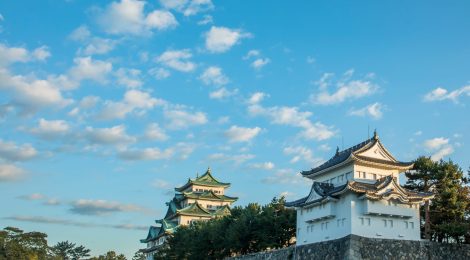
Nagoya Castle
Nagoya Castle: A Symbol of History and Beauty
Introduction:
Nagoya Castle, located in Nagoya, japan, is a reconstruction of a 17th-century castle that was destroyed during World War II. It is famous for its pair of golden fish-like shachihoko statues on the rooftop of the castle tower, which have become a symbol of the city. Despite its tragic past, Nagoya Castle stands as a reminder of the city’s importance throughout Japanese history and is now a popular tourist destination. In this article, we will explore the history, significance, and attractions of Nagoya Castle, as well as provide information on how to get there and what to expect during a visit.
History:
Nagoya Castle’s origins can be traced back to 1610 when it was built by Tokugawa Ieyasu, the founder of the Tokugawa shogunate. The castle served as the residence of the Owari branch of the Tokugawa clan until the Meiji Restoration in 1868. Throughout its history, Nagoya Castle played a significant role in Japanese politics and witnessed many important events. However, during World War II, the castle was reduced to ashes due to air raids.
Reconstruction:
After the war, the people of Nagoya were determined to rebuild their beloved castle. Reconstruction efforts began in 1957, and the castle tower was completed in 1959. The reconstruction aimed to faithfully recreate the original castle’s appearance, incorporating traditional Japanese architectural styles and materials. The result is a stunning structure that captures the essence of the original castle while offering modern amenities and facilities for visitors to enjoy.
Architecture and Design:
Nagoya Castle is an architectural masterpiece, featuring a five-story castle tower surrounded by impressive stone walls and moats. The castle tower stands at 48 meters tall and offers panoramic views of the surrounding cityscape. The interior of the castle is equally impressive, with exhibits showcasing the history and culture of the castle and its occupants. Visitors can explore various rooms, including the lord’s living quarters, meeting halls, and even a museum dedicated to samurai armor and weaponry.
The Shachihoko Statues:
One of the most iconic features of Nagoya Castle is its pair of golden shachihoko statues. Shachihoko are mythical creatures with the body of a carp and the head of a tiger. These statues are believed to have the power to summon rain and protect the castle from fire. The shachihoko statues on Nagoya Castle’s rooftop are not only visually striking but also hold great cultural significance. Visitors can marvel at these magnificent statues and even have their photos taken with a full-scale replica of one of them.
Cherry Blossom Season:
Nagoya Castle is particularly enchanting during cherry blossom season, which typically occurs in early April. The castle and its surroundings come alive with vibrant cherry blossoms, creating a picturesque setting for hanami, the traditional Japanese custom of flower viewing. Many locals and tourists gather in the castle grounds to celebrate the beauty of spring and enjoy picnics under the blooming cherry trees. The castle’s illuminated trees in the evening add a touch of magic to the atmosphere, making it a must-visit destination during this time of year.
Events and Activities:
Throughout the year, Nagoya Castle hosts various events and activities for visitors to enjoy. The summer festival in August, autumn celebrations in November, and a New Year celebration are especially popular. These events showcase traditional Japanese music, dance performances, and cultural exhibitions, providing visitors with a deeper understanding of the local culture. Additionally, on weekends, visitors may encounter samurai wandering the castle grounds. These friendly samurai offer opportunities for interaction, allowing visitors to learn more about the samurai’s way of life and even watch performances showcasing their martial skills.
Surrounding Attractions:
Adjacent to Nagoya Castle is Meijo Park, a beautiful green space that was once part of the castle grounds. The park features flower beds, a fish pond, and a windmill, providing a peaceful retreat from the bustling city. Meijo Park is popular year-round with locals and tourists alike, attracting joggers, families, and couples. During cherry blossom season, the park becomes even more vibrant, with families picnicking under the cherry trees and enjoying the festive atmosphere. On the other side of the castle, visitors can find the Aichi Prefectural Gymnasium, which hosts various exciting events, including the Nagoya Sumo Basho competition in July.
How to Get There:
Nagoya Castle is conveniently located and easily accessible from Nagoya Station, the city’s main transportation hub. From Nagoya Station, visitors can take a 25-minute walk to the castle. However, the quickest route is to take the subway to Shiyakusho Station. From Nagoya Station, take the Higashiyama Line and transfer at Sakae onto the Meijo Line to Shiyakusho Station. Signs and directions in English are available throughout the station, making it easy for visitors to navigate their way to Nagoya Castle.
Conclusion:
Nagoya Castle is not only a symbol of the city but also a testament to Japan’s rich history and cultural heritage. Its reconstruction after the devastation of World War II serves as a reminder of the resilience and determination of the Japanese people. A visit to Nagoya Castle offers a unique opportunity to immerse oneself in the grandeur of Japanese feudal architecture, learn about the castle’s history, and experience the beauty of cherry blossoms during the spring season. Whether you are a history enthusiast, a nature lover, or simply seeking to explore the cultural treasures of Japan, Nagoya Castle is a destination that should not be missed.
Address And Maps Location:
1-1 Honmaru, Naka-ku, Nagoya-shi, Aichi-ken
Subscribe, follow @idbcpr and idbackpacker.com